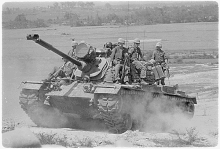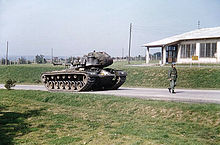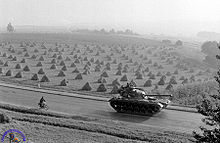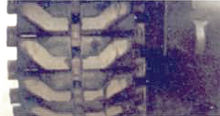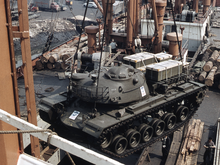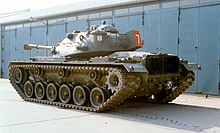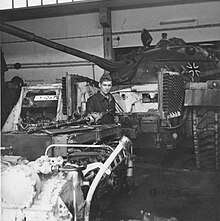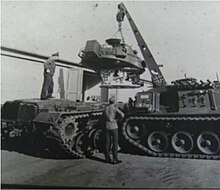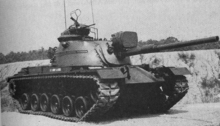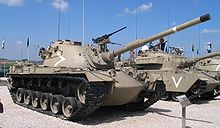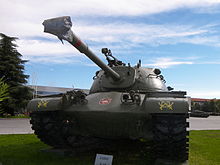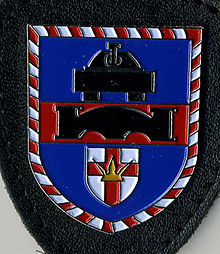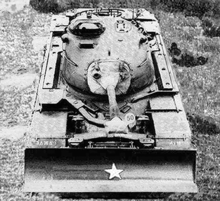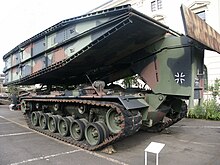M48 (main battle tank)
| M48 | |
|---|---|
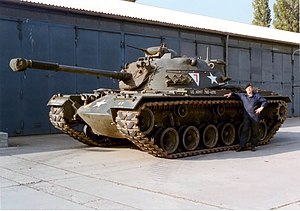
M48A2C - the German version despite the American emblems |
|
| General properties | |
| crew | 4 (commander, driver, gunner, loader) |
| length | 8.51 m |
| width | 3.63 m |
| height | 3.2 m |
| Dimensions | 45 t |
| Armor and armament | |
| Armor | Front tub above: 110 mm Front tower: 180 mm |
| Main armament | rifled cannon 90 mm M41 |
| Secondary armament | 1 × MG 12.7 mm Browning M2 , 1 × MG 7.62 mm M1919A4E1 |
| agility | |
| drive | Continental AV-1790-5B, 12-cylinder 4-stroke petrol engine with magneto ignition, displacement 29.4 l 810 hp |
| suspension | Torsion bar |
| Top speed | 45 km / h |
| Power / weight | 18 hp / t |
| Range | 110 km |
The M48 Patton is a battle tank of the time of the Cold War from American production. In various versions, it is still used today in some states. The official name of the Army Department was: "M48 Medium Tank - 90 mm Gun". The vehicle is named after General George S. Patton , the commander of the Third United States Army during World War II and one of the first supporters of massive tank operations on the Allied side.
In the US Army , the M48A5 was the last version of this model to be replaced by the M60 ; since the mid-1990s, the M48s have not been in service in the United States. The last in the home protection force of the Armed Forces M48A2C used were discarded without replacement, the M48A2GA2 by the Leopard 2 replaced.
history
As early as 1947, the US military demanded a longer-term solution for the procurement of a 30-tonne class battle tank with a 90-mm cannon. The M26 Pershing main battle tank, which had been in service since 1944/45, and its successor, the M46 , no longer met the requirements due to their low engine power and other weaknesses. The M47 main battle tanks manufactured since 1951 were only viewed as an interim solution from the start. Immediately after the start of production for the M47 in October 1951, development work for a successor began in the Detroit arsenal . In December of the same year, Chrysler received the order to build six prototypes called T48s. Even before Chrysler had finished the prototypes, the order for the first construction lots was received (initially also to Chrysler), which was followed the following year by further orders from Ford Motor Company and Fisher Body Division (a subsidiary of General Motors ). Delivery of the vehicle, now known as the M48, began in 1952.
In 1954, another construction lot was awarded to Chrysler.
The construction contract for the M48A2 was awarded to the company "Alco Products" in Schenectady ( New York ) in 1955 . The unit price at the time was $ 250,000 , making it $ 35,000 more expensive than its successor M60 fifteen years later.
In 1960, a control commission complained about serious faults in the vehicle that had meanwhile been found, which had not been detected because no troop attempt had taken place.
1975 began with the combat value increase from 500 M48A3 to M48A5. These vehicles were intended exclusively for the National Guard and were only used there. A total of 2067 tanks were converted to the A5 version. This action ended in 1980.
From 1952 to 1959 (according to other information in the years 1952 to 1960) almost 12,000 units of all variants were built. The M48 / M48A1 / M48C / M48A2 / M48A2C models used a petrol engine, the extremely high fuel consumption of which (in the best case 6 liters per kilometer) caused an unsatisfactory driving range. The development of a diesel engine began as early as 1959 and was built into the M48A3 models from 1963 (conversions of various older M48 types).
A large number of countries ordered the vehicles for their armored forces, including Germany (from 1956), Israel , Pakistan , Spain , Taiwan and Turkey .
crew
The crew of the M48 consisted of four soldiers (like most main battle tanks until the introduction of automatic loading): the commander, the driver, the gunner and the loader . The commander sat in the tower on the right under the rotating dome, the gunner sat in front of and below him. The loader was on the left side of the turret. The driver sat in the front centered in the tray of the tank. The soldiers housed in the tower had two hatches; the driver had his own hatch in the tub. There was also an emergency exit hatch in the bottom of the tub.
technology
Armament and ammunition
The M48 carried the 90 mm M41 drawbar cannon with an elevation range of –9 ° to + 19 ° and a lateral range of 360 °. The pipe had a smoke evacuator and a muzzle brake , which was available in two versions (Y and T version). The lock consisted of a drop block lock with an opening lever on the right and was not equipped with a case bag.
A 12.7 mm M2 machine gun in a mount outside the commander's cupola (model M48 and M48C) served as secondary armament . It could be used to combat lightly armored targets and for air defense. To the left of the main weapon was the M1919 coaxial machine gun, 7.62 mm caliber.
The ammunition that could be fired:
- APDS-T / Leuchtspur (Armor Piercing Discarding Sabot - Tracer)
- HEP-T ( squeeze head ammunition / tracer - High Explosive Plastic - Tracer)
- APERS (explosive projectile - anti-personnel)
The combat load consisted of 60 cartridges. The ready-to-use ammunition (a total of 20 cartridges) was housed eight cartridges in an ammunition magazine in the rear left side of the turret and twelve cartridges in the turret ring next to the loader. The radio was mounted in the right rear tower side. The main magazine was located to the left of the driver in the armored hull and could only be reached by the loader in the turret position from 12 to 7 a.m. The ammunition was not separated from the fighting compartment by a bulkhead.
The cartridges for the 12.7 mm machine gun were housed in storage boxes on the tower floor under the breech block. For the 7.62 mm ammunition there was a large magazine adapted to the curvature on the left tower wall above the turntable.
Armor
| Tub | tower | ||||||
|---|---|---|---|---|---|---|---|
| Tub, front, top: | 110 mm | Inclination angle: | 60 ° | cover | 110 mm | Inclination angle: | 30 ° |
| Tub, front, bottom: | 61 to 100 mm | Inclination angle: | 53 ° | Front: | 180 mm | Inclination angle: | 0 ° |
| Tub, front, side: | 76 mm | Inclination angle: | 0 ° | Pages: | 76 mm | Inclination angle: | 0 ° |
| Tub, rear, side: | 51 mm | Inclination angle: | 0 ° | Turret rear: | 51 mm | Inclination angle: | 0 ° |
| Rear, below: | 25 mm | Inclination angle: | 60 ° | Tower ceiling: | 13 mm | Inclination angle: | 0 ° |
| Rear, above: | 35.1 mm | Inclination angle: | 30 ° | ||||
| Tub bottom, front: | 38 mm | Inclination angle: | 90 ° | ||||
| Bath bottom, middle: | 31.8 mm | Inclination angle: | 90 ° | ||||
| Tub bottom, rear: | 13 mm | Inclination angle: | 90 ° |
Drive and chassis
| Engine: | air-cooled V12 petrol engine (four-stroke) Continental AV-1790-5B, -7, -7B, or -7C | Power: | 821 PS (810 bhp) or 645 kW at 2800 min −1 (revolutions / min) | Displacement: | 1791.7 cubic inches (29.4 liters) |
| Transmission: | Allison CD-850-4A or -4B, 2 forward gears, 1 reverse gear | Tank capacity: | 757 liters | Rollers: | 6 double castors |
| Control: | Mechanically via steering wheel, single-stage steering radius | Brake: | Multiple slices | Chain support rollers: | 5 double roles |
| Shock absorber: | 2 each on the front and 1 on the rearmost roller | Drive wheel: | 11 teeth / rear wheel drive | Suspension: | Torsion bar |
| Chain T96: | Rubber-backed battle link chain with central guide teeth | Chain width: | 71 cm | Chain links: | 79 |
| Support length: | 4.01 m | ||||
| Chain T97: | Rubber-padded connector chain with central guide teeth | Chain width: | 71 cm | Chain links: | 79 |
| Support length: | 4.01 m | ||||
| Speed: | 45 km / h max. | Trench crossing ability: |
2.59 m | Maximum bank slope: |
40% |
| Gradeability: | 60% | Climbing ability: | 0.91 m | Turning circle: | Turn around the vertical axis |
| Fording depth : | 1.20 m | Range per tank filling: |
approx. 120 km (max.) | Truncated cone springs: |
each side 2 front 1 back |
The hull and tower were made of cast armored steel . The 12.7 mm AA MG (Browning M2HB) was outside the commander's cupola. The rubber-padded connector chain T97 (usually this and not the war chain T96 was used) ran around six track rollers and five support rollers. The chain idler was located between the last wheel and the drive wheel. A Browning M1919 coaxial machine gun and an optical rangefinder were built into the asymmetrical turret. The vehicle did not have a smoke device. There was an emergency exit hatch behind the driver in the tub floor, which, however, could not always be reached by the tower crew, as it was blocked by the hydraulic block when the tower was in the directional area between 10 a.m. and 1 a.m. The driver had three, the gunner one, and the loader no corner mirror. The seats of the driver and the commander were height-adjustable, the loader's seat was always folded up in the rest position by spring tension. The heater, a bottle of the fire extinguishing system and the fittings for driving were installed on the right in front of the driver. The fire extinguishing system consisted of three bottles filled with halon (two more bottles were attached next to the driver) which only covered the engine area. The fire extinguishing system was triggered by a sensor, but could also be operated by the driver and people outside the vehicle by pulling the handle. The vehicle did not have a separate parking brake, the footbrake pedal was used for this purpose, which could be locked in various positions via a toothed segment when depressed. The gear selector switch was used for locking, which had to be set to position 0 all the way to the right. When the gear selector lever was returned to the 0 position, the brake would automatically open. In the left rear area of the tower was a bay window with a large-volume fan, which was equipped with a filter and already served as an NBC protection system. Carrying a target light and the possibility of deep wading were not planned. Contrary to German custom, the on-board tools were not stowed in the tower or attached to the tower and tub, but rather housed in storage boxes on the chain covers. On the one hand, these were used to save space in the tower and, on the other hand, should give the crew access to the sometimes quite bulky and unwieldy z. B. facilitate chain tensioning tool. Since they were not dust-tight, the parts housed here often became heavily soiled after off-road driving. At the stern of the tower was a tower cage to accommodate the luggage of the crew, the tarpaulin and the camouflage net. Holders for a 5-gallon (~ 19-liter) water canister were attached to the left and right of the sides of the tower. A watertight container for the outboard intercom system was attached to the rear of the tub. This consisted of a telephone receiver and a coiled cable about five meters long.
The engine was air-cooled and equipped with magneto ignition. The two fans for the cooling air were arranged one behind the other above the cylinders.
One of the main weaknesses of the vehicle was the insufficient range with a full tank, which is why it was possible to attach four petrol barrels of 55 gallons (210 liters) to the rear of the vehicle, thus increasing the range to around 220 kilometers.
Technical specifications
Manufacturer:
- Chrysler Corporation
- Ford Motor Company
- Fisher Tank Arsenal
| General | |||
|---|---|---|---|
| Operating weight | 45,000 kg | Height max. | 3.241 m |
| Length of the hull without cannon: | 6.767 m | Width: | 3,632 m |
| Total length with cannon at 12 o'clock position: | 8.516 m | Ground clearance: | 0.419 m |
| Free fire height: | about 2.0 m | Slewing ring diameter: | 2.16 m |
| Ground pressure : | 0.788 kg / cm² | cannon | 90 mm Gun M41 |
| Cannon ammunition: | 60 cartridges | Ammunition type: | HESH M87 |
| Tower turning range: | 360 ° | Elevation main weapon: | + 19 ° to −9 ° |
| Tower swing mechanism: | electro-hydraulic / manual | Tower rotation speed: | 14 seconds / 5 minutes |
| Elevation mechanism: | electro-hydraulic / manual | Elevation speed: | 4 s / 15 s |
| Anti-aircraft machine gun: | Browning M2HB 12.7mm | Ammunition supply: | 500 cartridges |
| Side straightening area: | manual 360 ° | Elevation range: | individually |
| Coaxial machine gun: | M1919A4E1 7.62mm | Ammunition supply: | 5900 cartridges |
| Rangefinder: | Room image T46E1 | Base: | 1.8 m |
variants
M48C
Identical to the M48, but made of structural steel and only used for training purposes. Total production rate: 120 vehicles.
M48A1
Manufacturer:
- Chrysler Corporation
- Ford Motor Company
- Fisher Tank Arsenal
| Changes compared to M48 | |
|---|---|
| Operating weight | 47,200 kg |
| Height max. | 3.08 m |
| Length of the hull without cannon: | 6.96 m |
| Total length with cannon at 12 o'clock position: | 8.8 m |
| Ground pressure: | 0.830 kg / cm² |
| Anti-aircraft machine gun: | Browning M2HB 12.7mm in M1 dome |
| Elevation range: | −10 ° to + 60 ° |
| Side straightening area: | 360 ° |
| Infrared driving device: | T41 |
The M48A1 had a larger driver's hatch with a slot to accommodate the infrared night vision device. For trips under infrared, the left two of the double headlights were provided as IR headlights with a corresponding pane. The previous commander's hatch on the tower was replaced by the M1 dome. This was equipped with four viewing blocks and adapted to accommodate the 12.7 mm machine gun previously attached to a mount. At the apex of the dome was a periscope that could be rotated through 360 ° . Due to the size of the ammunition box for the machine gun, the space in the dome was severely restricted.
M48A2
Production from 1956
Manufacturer:
- ALCO Products, Inc.
- Chrysler Corporation
| Changes compared to M48A1 | |
|---|---|
| Operating weight | 47,600 kg |
| Range finder | Stereoscopic M13A1 |
| Night vision driving device: | M24 |
| Fuel tanks: | 1270 liters |
| Driving range: | ~ 260 km |
| Auxiliary engine | 250 cc |
| Manufactured copies: | 2328 |
The M48A2 received a more efficient injection version of the Continental V12 engine. This had become more compact, which at the same time made space for larger fuel tanks. This more than doubled the range of the vehicle.
The exhaust system has been changed. Passages (radiator grilles) through which the exhaust gases and the engine cooling air were discharged were built into the rear wall of the tub. This was necessary to increase the cooling air flow. These passages took up the entire rear wall of the tub. They were attached to hinges and had to be opened like doors to remove the engine. The swirling of the cooling air with the exhaust gas stream cooled it, which in turn made infrared detection more difficult. The engine cover plate got higher and got a solid middle section because the air intake grilles were moved to the sides of the cover plate. The air flow and thus the cooling capacity increased as a result. The two oil bath air filters were relocated to the combat compartment and placed there on the left and right on the wall to the engine compartment. This made maintenance much easier.
The chassis was improved because the previous versions had defects. The chain tensioning wheel has been improved, and a reinforced truncated cone spring has been attached to the end stop of the front roller. The second and fourth chain support rollers have been removed. The driver received a larger steering wheel, and the gear lever was moved from its previous position in front of the steering wheel to the right next to the accelerator pedal. The exhaust gas routing of the heater was reduced by one pipe so that the tank only had one exhaust pipe instead of the previous two. This led from the tub to the left of the driver's hatch to the chain cover. Instead of the rounded ends at the bow and stern, the chain cover now has a kink with a bevel.
The fire control computer and the tower control system have been improved.
The vehicle was equipped with a 250 cm³ auxiliary motor that could be started electrically by the driver for battery charging and heating. The auxiliary motor allowed the number of batteries to be limited to four. These were located under the floor slabs of the tower. This auxiliary motor could be started manually in the event of a complete battery discharge. For this purpose, there was a cable running in a tube on the right chain cover, which was equipped with a rubber toggle at the end.
M48A2C
Manufacturer:
- ALCO Products, Inc.
- Detroit tank arsenal
The commander's cupola and the vertical direction of the machine gun were operated by hand cranks that engaged with a toothed ring or toothed segment via a gear. The trigger of the machine gun was electro-mechanical, for this a button on the elevation crank had to be pressed with the thumb, which activated a magnet via an electrical pulse, by which the trigger was operated.
The M48A2C model was essentially identical to the M48A2, only detailed changes were made.
The trigger of the coaxial machine gun was operated purely mechanically. To do this, a pedal had to be pressed that acted on the trigger via a Bowden cable .
The separate chain tensioning wheel between the last roller and the drive wheel was no longer needed, and the chain was now stretched over the pulley. The fire control computer was modified and the number of types of ammunition used increased.
- APDS-T / Leuchtspur Armor Piercing Discarding Sabot - Tracer
- HEP-T squeeze head ammunition / tracer: High Explosive Plastic - Tracer
- APERS explosive projectile : anti-personnel
- HEAT High Explosive Anti Tank : shaped charge projectile
- Canister : grapefruit
- WP white phosphorus : incendiary bullet
- HE High explosive: High explosive projectile, also with a delay fuse
- AP-T Armor piercing - Tracer: tank (full) bullet / tracer
The M48A2C version with the M17 rangefinder was introduced for the Bundeswehr. The lighting system was converted in accordance with the StVZO , the coaxial machine gun was converted to MG1 or MG3 , a white-light target headlamp was adapted to the left above the cannon with a storage box at the rear of the tower, the German smoke-throwing system was attached to the tower and the SEM 35 radio was installed . The M2 machine gun was retained. The infrared system was later replaced by a residual light amplifier , known as a biv device in jargon . The vehicles were used by the German Armed Forces immediately after their arrival from the United States. The conversions were then carried out gradually. Attempts in the 1980s to equip the device with mine clearance rollers made by Israel have been given up.
M48A3
Production from 1967
Manufacturer: Bowen-McLaughlin-York, Inc.
| Changes compared to M48A2C | |
|---|---|
| Operating weight | 48,500 kg |
| Ground pressure | 0.852 kg / cm² |
| Height: | 3.31 m |
| Coaxial machine gun: | M73 7.62 mm |
| Rangefinder: | M17A1 |
| Infrared driving device: | M24 |
| Machine: | Continental AVDS-1790-2A; 90 ° -12-cylinder, 4-stroke, diesel |
| Power: | 550 kW (750 PS) at 2400 rpm |
| Fuel tank: | 1460 liters |
| Transmission: | General Motors CD-850-6A |
| Chain: | Rubber padded connector chain M97E2 |
| Range: | ~ 480 km |
The vehicle was originally produced specifically for the South Vietnamese Army , although there is evidence that they were - at least partially - used by the US armed forces. It was not a matter of new buildings, but of converted M48A1s. These were fitted with a diesel engine in order to save fuel and reduce the risk of fire in a vehicle powered by gasoline. The M60 exhaust system was installed in the rear and the oil bath air filters were replaced by dry air filters. The auxiliary engine was removed as it was no longer needed; the tank capacity was increased and even exceeded that of the M48A2, as the space of the auxiliary engine could also be used for this.
The fire control system was modified and the ammunition box for the dome machine gun was reduced by half to 50 cartridges. Even so, the tank commander still had to cope with extremely cramped conditions.
At the request of the South Vietnamese, an additional ring of viewing blocks was inserted between the commanders' cupola and the tower roof. This was more generously dimensioned than the viewing blocks in the commander's cupola above and was intended to provide a better overview when deployed in the jungle. This increased the vehicle silhouette by 13 centimeters. A device for attaching a white light / infrared target light had been installed on the gun mantlet, but there was no storage box for the light.
The vehicles converted in this way were designated as M48A3 (Mod A). Then another 578 vehicles were converted (Mod B), but the rear was improved. The exhaust outlets were reinforced with a frame and the rear lights were better protected from damage. The outboard intercom has been moved higher from the stern to the right rear chain cover. The instruments of the M60 were installed for the driver, the fuel lines were laid and the main headlights made removable. The vehicles received infrared telescopic sights. After this work was completed, the A-models were also brought up to date, so that the designations Mod A and Mod B were no longer used.
M48A4
It was planned to subject the M48A3 to an upgrade after the conversion of the M60A1 main battle tank to the M60 A2 main battle tank with the freed towers of the M60A1 and to assign the vehicle the designation M48A4. Since the M60A2 turned out to be of little use and the conversion was stopped immediately, the project was abandoned. It remained with a test sample.
M48A5
Production from October 1975
Manufacturer: Anniston Army Depot
| Changes compared to M48A3 | |
|---|---|
| Cannon: | 105 mm M68 |
| Ammunition supply: | 54 rounds |
| Overall length: | 9.31 m |
| Height: | 3.06 m |
| Operating weight | 49,000 kg |
| Range finder | M17B1C |
| Night vision driving device: | M24 |
| Machine guns: | 2 × M60 on the tower |
| 1 × M219 or M240 coaxial to the main weapon | |
| Ammunition supply: | 10,000 rounds |
| Visor armor: | 11 cm |
| Manufactured copies: | 2069 |
The M48A5 was created by converting the models M48A1 and M48A3.
The progressive uselessness of the 90 mm cannons compared to those of the potential opponents made it necessary to increase the combat value of the M48A3. For this purpose, the vehicle was equipped with the fascia and the 105 mm M68 cannon of the M60 tank. Also all possible more modern parts of the M60 replaced the outdated equipment of the M48A3. The very large M1 dome was replaced by an Israeli version (Urdan model) in August 1976. This was flatter and equipped with three corner mirrors. Furthermore, she had a vertically lockable hatch, which gave the commander some additional protection.
The heavy anti-aircraft machine gun on the commander's cupola was replaced by an M60 machine gun; the loader also received such a weapon on a carriage. The total ammunition equipment of the 7.62 mm ammunition increased to 10,000 rounds. Some of the vehicles initially retained the A3 commander's cupola; the vehicles, which had been equipped with the new dome from the start, were initially semi-officially designated as M48A5PI (M48A5 Product Improved). However, when all vehicles had reached the final level of the combat value increase, this designation was dropped again.
The relevant photos show the vehicle with a target headlamp attached, but here too there is no storage box for the headlamp.
The M48A5E1 was a modified M48A5 with a digital fire control computer, laser range finder and improved night vision device.
M48A2GA2
From 1978 onwards, 650 M48A2Cs of the Bundeswehr were equipped with the 105 mm L7 cannon of the Kpz Leopard 1 and with another gun mantlet . In addition, the commander's cupola was removed and replaced by the corner mirror ring of the bridge-laying tank "Biber" . The MG3 machine gun was now used for anti-aircraft defense and to combat small targets . The telescopic sight was also converted to the passive night target and observation device PZB 200. The tank battalions of the 2nd and 4th Jägerdivision ( Kassel and Regensburg ) and some of the partially mobile tank battalions of the homeland security force were equipped with these vehicles . After the Jäger divisions had been converted into Panzergrenadier divisions, they also received the Leopard 2 battle tank . The M48A2GA2 were assigned to the partially mobile and inactive tank battalions of the Territorial Army, where they, including those of the M48A2C type, were used until these units were dissolved (around 1993).
Combat value increases in other countries
Israel
M48A3 ISR and M48 / 105 ISR - From 1970 onwards, the Israeli army carried out many changes in demand on the tanks supplied by the United States (or captured by Jordan) that did not conform to the standard of the US Army. Much improvisation was made and empirical values were used; what was at hand was also often used. An unknown number of the M48 hulls were fitted with the turret and 105 mm cannon of the British Centurion tank. This combined the higher firepower with the better drive and drive. Israel also developed the so-called Urdan dome for the M48, which replaced the old M1 commander's dome and was also used in the USA for the M48A5. After the end of the Six Day War, the Israeli army began another modernization program for most of the M48s in use: they received new diesel engines and the L7 105mm cannon.
Jordan
AB9B1 - Jordanian combat enhancement with a 120 mm smoothbore cannon
Taiwan
- M48A3 (ROC variant) - Most of the M48A3 vehicles used here were not equipped with a diesel engine.
- M48H / CM-11 "Brave Tiger" - increased combat value by using an M48A2 turret with a 105 mm cannon and M60A3 hull and engine. Improvement of the fire control system.
- M48A3 / CM-12 upgrade of the M48A1 / A2 with the same weapon and fire control system as CM-11
Greece
M48A5 MOLF - Installation of the EMES-18 FCS fire control system - "MOLF" designation for Modular Laser Fire Control System.
Spain
M48, M48A5E - M48A5 variant, with laser rangefinder.
South Korea
- M48A3K - equipment with a diesel engine, replacement of the Y-muzzle brake with the T-model. The number of chain support rollers was increased from three to five, the commander's periscope was replaced with a Korean model, as was the fire control system.
- M48A5K - Increase in combat value through the installation of the 105 mm KM68 cannon. Attachment of side skirts and replacement of the fire control system with the Laser Tank Fire Control System (LTFCS).
Turkey
- M48A5T1 - Turkish combat value increase of the existing M48 to the level of the M48A5 by installing an MTU diesel engine, a passive night vision device and the M68 105 mm cannon.
- M48A5T2 - Improved version of the M48A5T1 with FNSS thermal night vision device and laser rangefinder.
- M48T5 "Tamay" ARV - Armored recovery vehicle made in Turkey on the M48 chassis
Vehicles based on the M48
M48A2DB (DB - Dozer blade) and M48RPz / M48A2CR
For clearance work, there was the M48A2DB, a forerunner of the pioneer tank . In the Bundeswehr , which was under construction , the tank pioneer companies were initially equipped with the M48A2DB known as a "Räumpanzer", an M48 battle tank with an M8A1 type clearing shield ( bulldozer, earth moving, tank mounting M8 ). The clearing blade, which had to be operated by the driver, was moved by means of a cable (the lowering was carried out by the weight of the blade itself, so it was not possible to push the blade into the ground to achieve better clearing performance) and could only be used vertically (no cutting angle adjustment). Due to the design, only rough work was possible. At the end of his active service he could only be found with the tank pioneers of the 2nd and 4th Jäger Divisions. The on-board cannon had already been deactivated at this point, as there was no more ammunition available. The on-board cannon was then completely removed and the vehicle with the type designation Pionierpanzer M48A2CR was stored in the equipment units of the homeland security force (including PzPiSperrKp 741) until the end of the 1990s
Mine clearance tank Keiler
Mine-clearing vehicle based on the M48 hull. Last vehicle of this model series in the Bundeswehr.
see main article: Keiler (tank)
M67 / M67A1 / M67A2
This flame thrower tank was based on the hulls of the M48A1 (M67) - M48A2 (M67A1) and M48A3 (M67A2) models. The very fragile and soon retired vehicles were only used by the marines in Vietnam .
The US Army had abandoned the development of flame throwing tanks in 1948, but the Marine Corps continued work to obtain a usable medium flame throwing tank. This was based on the experiences one had made with such vehicles in the fight against Japan on Okinawa and Iwojima . A prototype named T66 was completed in May 1952. But it was too late for the Korean War. However, the attempts were promising, the range was up to 280 yards (~ 252 meters).
When the M48 was available, this vehicle began to be modified for the required purpose. The M48A2 could be equipped with a specially made flamethrower tower M7A1-6. This led to the M67 model, which was produced from 1953. It was also possible to convert the tank into a flamethrower tank within eight hours using the Chrysler T-89 upgrade kit. The fuel oil supply was 365 gallons (~ 1380 liters) and was in a tank that had been placed in the armored hull in place of the front ammunition magazine.
The actual flame tube was built into a replica of a 90 mm cannon. This sheet metal tube was provided with ventilation openings to allow air to enter the combustion chamber and thus enable ignition. The tower underwent a serious change through the installation of the fittings and control organs on the side of the (no longer available) loader. As a result, the tower could only be entered or exited through the commander's hatch, even if the hatch could still be opened for better ventilation.
The elevation range was + 45 ° to -12 °, the outlet pressure of the oil with a ⅞-inch orifice was 300 psi (~ 20.6 bar). The duration of the flame emission was 55 to 61 seconds.
The crew consisted of three soldiers. The gunner operated the flamethrower and the coaxial machine gun.
The vehicle was called the " Zippo " by the troops .
M48A2 AVLB
Demands by the US military led to the development of an Armored Vehicle Launched Bridge, which should meet the requirements of the M48 tank in terms of speed and bridge load-bearing capacity. First attempts to equip excess M46 chassis with a twelve-meter-long scissor bridge did not lead to any result, so that the M48 hull had to be used. The new model received a 19.5 meter long scissor bridge and proved to be extremely successful - even if the fuel consumption was beyond the limits. A consumption of up to 800 liters per 100 kilometers of off-road driving (depending on the nature of the ground) was quite possible. At that time it was the heaviest tracked vehicle in the Bundeswehr.
see main article: M48 bridge-laying armor
Combat missions
Vietnam War
No fewer than 600 M48 main battle tanks were used in the Vietnam War. The first tank troops to be relocated to Vietnam were the 1st and 3rd Tank Battalions of the US Marines in 1965 . The 5th Tank Battalion, which was added later, was used as a reinforcement unit. There were also three US Army tank battalions in action in Vietnam; the 1./77. Panzer Regiment (1-77th Armor) near the demilitarized zone, the 1st/69 Panzer Regiment (1-69th Armor) in the Central Highlands and the 2nd/34. Panzer Regiment (2-34th Armor) in the Mekong Delta . The Armored Cavalry Squadrons also used the M48 until it was replaced by the M551 Sheridan in these units ,
The M48A3, which had been handed over to the army of the Republic of Vietnam , were used by them, among other things, to set up the 20th Panzer Regiment. Furthermore, the South Vietnamese supplemented their tank formations equipped with the M41 Walker Bulldog .
During the North Vietnamese Easter Offensive in 1972, tank fights between North Vietnamese T-54 / PT-76 and South Vietnamese M48 / M41 were the order of the day. On April 23, 1972, the North Vietnamese Army successfully used the 9M14M “Maljutka” anti-tank guided missile (NATO code: AT-3 Sagger ) for the first time. A tank hunter destroyed an M48A3 and an M113 MTW (Armored Cavalry Assault Vehicle / ACAV) of the 20th Panzer Regiment.
The M48 proved itself surprisingly well in infantry support, which was its main task anyway, since (until 1972) only very few classic tank battles took place. One of them was delivered near Ben Het in 1969 by the 1st Battalion of the 69th Panzer Regiment and the North Vietnamese 202nd Panzer Regiment, the latter equipped with PT-76.
During the spring offensive in 1975 the South Vietnamese M48 and M41 fought against the North Vietnamese army and were able to inflict massive losses on the T-34 and T-55 formations and thus delay the fall of Saigon by a few days. However, since the US Congress imposed a freeze on the delivery of ammunition and fuel to Vietnam after the withdrawal of the American armed forces , many of the South Vietnamese tanks soon had to be abandoned due to a lack of supplies and fell into the hands of the North Vietnamese; some of the captured vehicles were taken over by the Vietnamese People's Army after the end of the war.
Indo-Pakistani War
The Pakistani Army had only one division , which deserved the name " Panzer Division ", although not all of these vehicles were of the M48 type. These M48s (together with the M47s ) were used against the Centurions and M4 Shermans of the Indian Army . In the battle near Kutch, the Pakistani tanks were surprisingly able to repel the Indian attackers despite the swampy terrain.
During Operation “Grandslam”, the Pakistani armored forces broke through the Indian lines and smashed counter-attacks by armored units. In the battle of Asal Uttar (September 8-10, 1965), however, the Indians succeeded in destroying a total of 97 Pakistani tanks, most of them M48. The tanks then fought in the Battle of Chawinda with satisfactory results. The Patton tanks spearheaded the advance through Chamb and were the backbone in the battle of Shakarghar. Later in the battle, a tank brigade (The Changez Force) successfully fended off an Indian attack that was led into the retreat near Chawinda.
India later erected a memorial called "Patton Nagar" (Patton City), where the captured and shot down Pakistani tanks are displayed.
In an analysis of the events, the Pakistani army came to the conclusion that the combat power of the M48 tanks was respected by friend and foe and that the losses incurred in the Asal Uttar debacle were less due to the material than to the embarrassing tactics of the Pakistani leadership was to blame.
In retrospect, a study by the US Army found that the armor of the M48 could be penetrated by both the 20-pounder (84-mm) cannon of the Centurion and the 75-mm cannon of the AMX-13 .
In the Indo-Pakistani War of 1971 , the M48 were used with varying degrees of success.
middle East
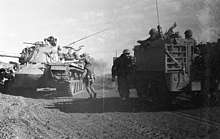
In 1964, at the urging of the USA, the federal government agreed to give Israel 150 M48 A1s that were to be retired. Only 40 of them had been delivered when the confidentiality agreement was discovered and delivery was subsequently stopped. In 1965 Israel finally received 90 more modern M48A2Cs, which the Federal Republic of Germany had ordered and paid for in the USA especially for this purpose. In addition, there were 20 M48s from Bundeswehr stocks that had been converted to the M48A2C standard.
In the 1967 Six Day War , the M48 was used by Israel against the Egyptian T-34 and T-54 on the Sinai Peninsula . Thanks to the superior tactics and training of the Israeli tank crews, most of the duels with enemy tanks were won. However, the conflict also revealed the disadvantages of the M48, as the 90mm cannon reached its limits in terms of penetration power and range. In addition, the tank quickly caught fire when hit because of the petrol operation, which was doomed for many Israeli crews. After the Six-Day War, the German ambassador to Israel reported that an Israeli general staff officer had told him that the M48s delivered by the Federal Republic had proved their worth.
The M48 tanks fighting on the Jordanian side in the West Bank were often knocked out by the Israeli World War II M4 Shermans (modified with French 75 and 105 mm cannons). Although the Jordanian M48s were technically superior to the Israeli tanks - shots by the Israelis from a distance of more than 1000 meters often only ricocheted off - the Israeli air superiority and the low morale of the Jordanians ultimately led to the well-known result. The Israeli army captured around 100 Jordanian M48s, which were integrated into their own armored forces after the end of the war.
The Lebanese army used M48 tanks in the civil war , as did Christian militias.
Africa
Smaller conflicts such as uprisings and revolutions are not listed here. It is worth mentioning, however, the use of Pakistani M48s in 1993 in the Battle of Mogadishu to cover the withdrawal of US troops from the city.
User states
Still in use
- Turkey - 1576 M48A5T1 and M48A5T2 (2019) No longer in use as of 2020.
- South Korea - 233 M48A3K and 597 M48A5K (2019) No longer in use as of 2020. become.
- Lebanon - 54 M48A5 upgraded (2018)
- Republic of China - 265 M48A3 upgraded to CM-12, 100 M48A5 (2019)
- Thailand - 150 M48A5 (2019)
No longer in use
- Greece - 390 M48A5 MOLF (to be discarded)
- Iran - according to Global Security, it has not been in existence since 2013
- Israel - 450 copies in 1972, 200 Magach currently in storage
- Jordan - 200
- Yugoslavia
- Pakistan - 345 M48A5
- Portugal - 86 M48A5 (replaced by 36 Leopard 2A6 )
- Morocco - 185 M48A5 (stored since 2009)
- Norway - 38 M48A5
- Spain - 164 M48A5E (replaced by Leopard 2A4)
- South Vietnam
- Federal Republic of Germany
- Tunisia - 28 M48A5 (no longer listed in 2015)
- United States
- Vietnam - 20–40 vehicles captured by South Vietnam (now separated due to lack of spare parts)
literature
- FM by Senger and Etterlin : Tanks of the World 1983. Arms and Armor Press, London 1983, ISBN 0-85368-585-1 .
- RP Hunnicutt: Patton: A History of the American Main Battle Tank. volume 1. Presidio Press, Navato, CA 1984.
- Fred W. Crismon: US Military Tracked Vehicles. Motorbooks International, Osceola, WI 1992.
- David Miller: The Illustrated Directory of Tanks of the World. MBI Publishing Co., Osceola, WI 2000.
- Technical service regulation of the Bundeswehr battle tank M48A2C. Part 22.
- Technical service regulation of the Bundeswehr battle tank M48A2C. Part 12.
- Technical service regulation of the Bundeswehr M48A1 battle tank. Part 22.
- Technical service regulation of the Bundeswehr M48A1 battle tank part 12
- Technical service regulation of the Bundeswehr battle tank M48A2GGA2. Part 22.
- Technical service regulation of the Bundeswehr battle tank M48A2GGA2. Part 12.
- Technical service regulation of the Bundeswehr Pionier-Räumpanzer M48. Part 22.
- Technical service regulation of the Bundeswehr M48 bridge-laying tank. Part 22.
- Technical service regulation of the Bundeswehr M48 bridge-laying tank. Part 12.
- Oscar C. Decker: The Patton Tanks: The Cold War Learning Series.
- Christopher F. Foss : Modern Tanks. HarperCollins Publishers, Glasgow 1995.
- Christopher F. Foss: Tanks and Other Fighting Vehicles 1916 to Today. Buch und Zeit Verlagsgesellschaft, Cologne 1977.
- Keith W. Nolan: Into Lao's, Operation Lam Son 719 and Dewey Canyon II. Presidio Press, Account of the US Army's final offensive of the Vietnam War, 1986.
- Abraham Rabinovich: The Battle for Jerusalem June 5-7, 1967. Sefer Ve Sefer Publishing, Jerusalem, 2007, ISBN 965-7287-07-3 .
- General Donn A. Starry: Mounted Combat In Vietnam. Department of the Army, Vietnam Studies, 1989.
- Simon Dunstan: Vietnam Tracks-Armor in Battle. Osprey Publishing, 1982, ISBN 0-89141-171-2 .
Web links
Individual evidence
- ^ Department of the Army - Field Manual FM 17-79 M48 Medium Tank - 90 mm Gun - October 1955
- ^ Technical regulations of the Bundeswehr M48A1 battle tank. Part 12 p. 26 ff.
- ↑ Technical service regulation of the Bundeswehr battle tank M48A2C part 22, page 8 ff
- ↑ similar to a lawn mower
- ↑ Technical Service Regulations of the Bundeswehr M48A2C Main Battle Tank Part 22, page 24 ff.
- ↑ Also known as HESH - High Explosive Squash
- ↑ FM by Senger and Etterlin Tanks of the World 1983 Arms and Armor Press London 1983 p. 464
- ↑ Technical regulations of the Bundeswehr battle tank M48A2GA2 part 22, page 8 ff
- ↑ FM by Senger and Etterlin: Tanks of the World 1983 , Arms and Armor Press, London, 1983, p. 467
- ↑ Technical service regulation of the Bundeswehr Pionier-Räumpanzer M48 part 22, page 8 ff
- ↑ Captain John Ringquist US Army Flamethrower Vehicles (Part Three of a Three-Part Series)
- ↑ a b The T-34 in Vietnam - wwiiafterwwii. In: wwiiafterwwii.wordpress.com. Retrieved October 22, 2016 .
- ↑ Christer Jorgensen, Chris Mann: Tank battles - An illustrated history of the tank wars from 1914 to today , p. 164.
- ↑ M47 & M48 Patton in Pakistani Service ( Memento from September 2, 2012 in the Internet Archive )
- ↑ Niels Hansen : From the shadow of the catastrophe. German-Israeli relations in the era Konrad Adenauer and David Ben Gurion , Droste, Düsseldorf 2002, ISBN 3-7700-1886-9 , pp. 539–742.
- ↑ Niels Hansen: From the shadow of the catastrophe. German-Israeli relations in the era of Konrad Adenauer and David Ben Gurion , Droste, Düsseldorf 2002, ISBN 3-7700-1886-9 , p. 624
- ↑ [1]
- ↑ https://www.globalsecurity.org/military/world/rok/army-equipment.htm
- ↑ https://www.globalsecurity.org/military/world/taiwan/army-inventory.htm
- ↑ [2]
- ^ Edward Luttwak , Dan Horowitz: The Israeli Army , Allen Lane, London 1975, ISBN 0-7139-0229-9 , p. 182
Remarks
- ↑ The types of ammunition changed or were added to the subsequent types.
- ↑ Allison was a subsidiary of General Motors
- ↑ Different versions also show reserve chain links
- ↑ The range information is of a theoretical nature. The actual range depended solely on the nature of the ground.
- ↑ This system was then adopted for the Leopard family
- ↑ The truncated cone spring is the last obstacle before the swing arm, which leads from the torsion bar to the roller, reaches the end stop on the tub.
- ↑ The Bundeswehr was initially equipped with the M48A1 model, which was soon replaced by the M48A2C.
- ↑ Troop test of the pioneer school with the support of the BWB 1988–1989
- ↑ This is discussed at the end of the film "Black Hawk Down"

